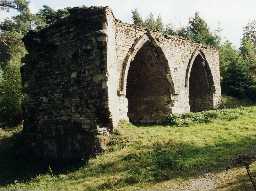Local History
Slaley (Northumberland)
Slaley is a relatively small parish in south Northumberland. Many tributaries of the Tyne flow across the parish and large forestry plantations are planted in the upland parts.
No direct evidence exists for early prehistoric life in the parish. It is only in the Iron Age that the first sign of former inhabitants occurs. An undated circular enclosure at Hollies House, overlain by medieval activity, might well be later prehistoric in date.
In the medieval period several settlements grew up in the parish, including Sessinghope, Wooley, Dukesfield and possibly Merchingley as well. Rare remains of a medieval house are incorporated into the farm buildings at Shield Hall, apparently of 13th or 14th century date. It predates many of the later and more common tower houses and bastles of Northumberland. There is a documentary reference to a church at Slaley at this time, but is has since been rebuilt. A millstone quarry once operated at Slaley and is known from historical documents. Much of medieval life was dominated by religion and monasteries are known in the nearby area at Blanchland and Hexham. These religious houses developed great estates away from the main church and the Hermitage and Chapel of St Mary, given to Kelso Abbey in Scotland, may lie in this or the neighbouring parish of Broomhaugh and Riding. The wealth of these houses may have attracted Scottish raiders, known to have attacked Blanchland and en route Merchingley. Merchingley seems never to have been resettled, an unusually definitive statement for the cause of abandonment.
The need for defence unfortunately extended into the 16th and 17th centuries when this area saw much unrest and fighting between different border families, or reivers. It became necessary for those who could afford it, to construct special defended farmsteads, now known as bastles at Church View and Todburn Steel. The buildings at Shield Hall were adapted to agricultural uses in this peaceful climate. Being on the fringe of the North Pennines, there was only limited exploitation of mineral resources. Instead a smelt mill operated in the Devil's Water area at Dukesfield, processing the Galena mined elsewhere.
No direct evidence exists for early prehistoric life in the parish. It is only in the Iron Age that the first sign of former inhabitants occurs. An undated circular enclosure at Hollies House, overlain by medieval activity, might well be later prehistoric in date.
In the medieval period several settlements grew up in the parish, including Sessinghope, Wooley, Dukesfield and possibly Merchingley as well. Rare remains of a medieval house are incorporated into the farm buildings at Shield Hall, apparently of 13th or 14th century date. It predates many of the later and more common tower houses and bastles of Northumberland. There is a documentary reference to a church at Slaley at this time, but is has since been rebuilt. A millstone quarry once operated at Slaley and is known from historical documents. Much of medieval life was dominated by religion and monasteries are known in the nearby area at Blanchland and Hexham. These religious houses developed great estates away from the main church and the Hermitage and Chapel of St Mary, given to Kelso Abbey in Scotland, may lie in this or the neighbouring parish of Broomhaugh and Riding. The wealth of these houses may have attracted Scottish raiders, known to have attacked Blanchland and en route Merchingley. Merchingley seems never to have been resettled, an unusually definitive statement for the cause of abandonment.
The need for defence unfortunately extended into the 16th and 17th centuries when this area saw much unrest and fighting between different border families, or reivers. It became necessary for those who could afford it, to construct special defended farmsteads, now known as bastles at Church View and Todburn Steel. The buildings at Shield Hall were adapted to agricultural uses in this peaceful climate. Being on the fringe of the North Pennines, there was only limited exploitation of mineral resources. Instead a smelt mill operated in the Devil's Water area at Dukesfield, processing the Galena mined elsewhere.
N13803
UNCERTAIN
Disclaimer -
Please note that this information has been compiled from a number of different sources. Durham County Council and Northumberland County Council can accept no responsibility for any inaccuracy contained therein. If you wish to use/copy any of the images, please ensure that you read the Copyright information provided.
